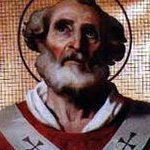
Pope St. Hormisdas was the 52nd pope and is a recognized Catholic saint. Though his name is Persian, he and his father and son were born in Italy under the Roman Empire. This article will explore the fun and insightful facts about Pope St. Hormisdas.
The Acacian Schism
Pope St. Hormisdas’ papacy was largely defined by healing the Acacian Schism and reuniting the Church. The Acacian Schism lasted for an official 35 years between 484 – 519. It represented a split between the Byzantine Empire in the East and the Roman Catholic Church in the West.
The Eastern Empire, under Emperor Zeno leaned towards Monophysitism, which was in direct opposition against the Pope St. Symmachus. This division remained at a stalemate due to the contention for the two leaders, Emperor Zeno and Pope St. Symmachus. When Pope St. Hormisdas came to leadership, the course of the issue was redirected.
Letters with Emperor Anastasius
By 514, the Byzantine Empire was now under Emperor Anastasius’ rule, who like the newly elected Pope St. Hormisdas wanted to end the Acacian Schism. On December 28 of that year, Emperor Anastasius wrote to Pope St. Hormisdas, asking him to attend a synod in the summer of the following year. Unfortunately, Pope St. Hormisdas got the second letter first, which was more condescending in nature.
To the second letter, Pope St. Hormisdas replied on April 4, 515, and agreed to the synod. Though looking for peace, Pope St. Hormisdas reaffirmed his support in the Western Church’s identity, belief, and lineage. Eventually, in May, the first letter arrived, putting Pope St. Hormisdas on guard.
The Synod
The Emperor’s synod on July 1, 515 held over two hundred bishops. Despite lofty goals of peace and high attendance, not much was resolved. Both the Acacian Schism and the tensions remained ever-present.
Meanwhile, Pope St. Hormisdas sent two bishops to Constantinople to discuss things more directly. As his emissaries, he sent two bishops and a priest, deacon, and notary. On July 8, 515, they met to give the terms of Pope St. Hormisdas to end the Acacian Schism.
Demands and Their Reception
Pope St. Hormisdas wanted the schism to end but felt several things needed to occur for that to happen. Chief among these was the Emperor’s and Eastern bishops’ acceptance of the Council of Chalcedon and with it the principals of the Western Catholic Church. Anyone exiled due to their original support of the Council of Chalcedon must be allowed to return, and those who persecuted them should be judged.
The Emperor did not take to these terms well. He felt that Pope St. Hormisdas vied to be recognized as the one true authoritative leader of the entire Catholic Church. Thus, the Acacian Schism lasted longer.
A Final Ending to the Acacian Schism
Following the Emperor’s synod and the Pope’s terms of the agreement, more of the same took place, leading to the same extension of division. Emperor Anastasius tried to pit the Roman Senate and monarchy against Pope St. Hormisdas, who kept trying to appeal in writing.
Then, Emperor Anastasius died rather suddenly. His successor, Justin I, quickly agreed to all the Pope’s terms. To commemorate the end of the Acacian Schism, a ceremony was held on March 28, 519.
List of Events In The Life of Pope St. Hormisdas
| Date | Event | Title |
|---|---|---|
| 20 Jul 514 | Elected | Pope (Roma, Italy) |
| 20 Jul 514 | Ordained Bishop | Pope (Roma, Italy) |
| 6 Aug 523 | Died | Pope (Roma, Italy) |
Quick Facts About Pope St. Hormisdas
- He was born circa 450 in Frusino, Italy under the Western Roman Empire.
- His Persian birth name is the only one attributed to him and is likely named after Hormizd, a Persian prince.
- He died in office on August 6, 523 around the age of 73.
- His death is presumed to be due to natural causes. He is buried in the portico of St. Peter’s.
- Around the age of 64, he became the Pope on July 20, 514.
- His papacy lasted just over nine years, ending with his death on August 6, 523.
- He was preceded by Pope St. Symmachus, who served nearly 16 years.
- Pope St. John I followed his papacy, holding the office for almost 3 years.
Interesting Facts About Pope St. Hormisdas
- He is the father of the 52nd Pope Silverus.
- His feast day is August 6.
- He was the first Pope of the 6th century.
- The confession the Eastern bishops signed per his terms is known as Formula of Hormisdas.